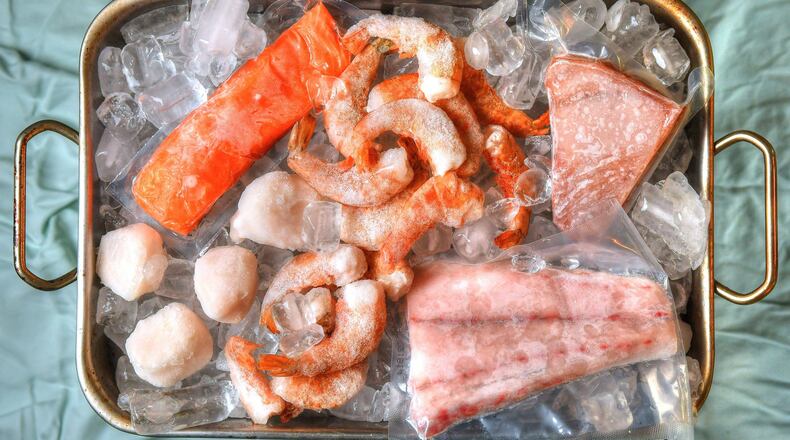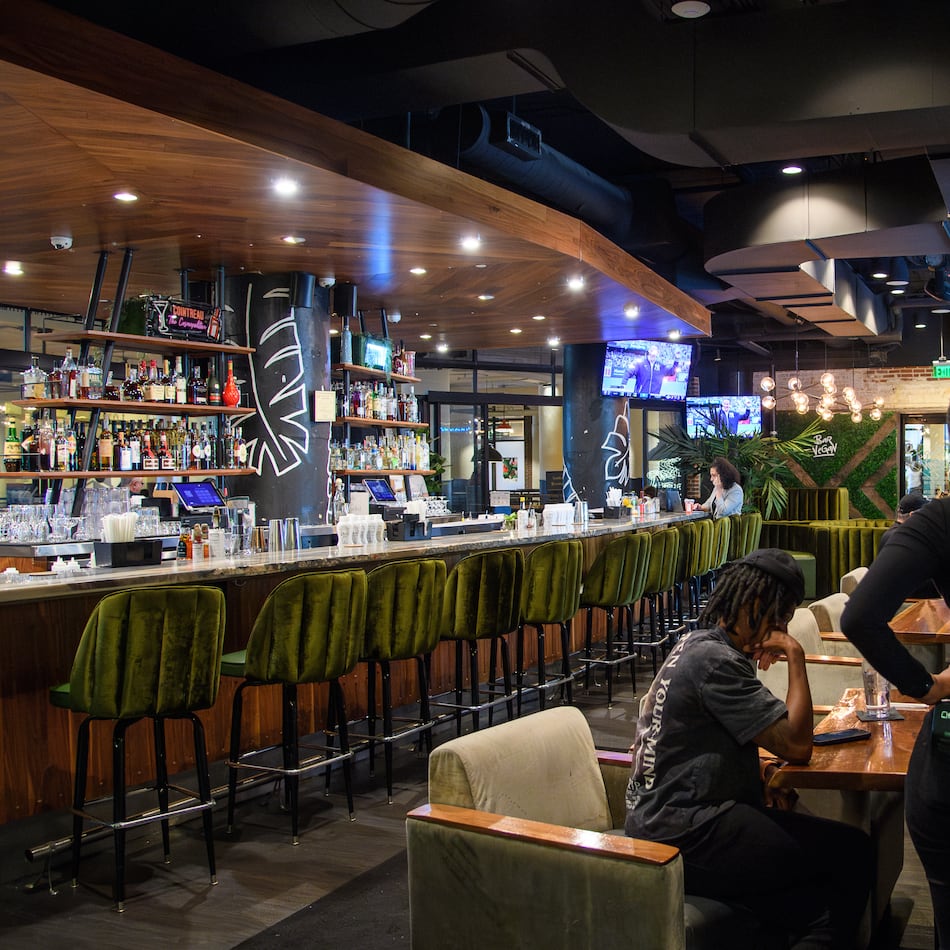In the tiny bayou town of Chauvin, Louisiana, where Melissa Martin grew up, practically every home has a large chest freezer — sometimes two.
“We’re like a fish factory down there,” says the chef and author of “Mosquito Supper Club: Cajun Recipes From a Disappearing Bayou” (Artisan Books, $35). “My family fishes every day. They fillet what they catch, eat some fresh right away, and freeze the rest for later.”
Today at her intimate New Orleans restaurant for which her book is named, she serves seafood she buys directly from local fishermen she knows. Almost all of it, other than crab and crawfish, has been previously frozen.
“It’s a delicacy to be able to catch a fish and immediately put it on the grill,” says Martin. “But if you can’t do that, there’s nothing wrong with frozen seafood, if you buy from a trusted source.”
Among consumers who must rely on the supermarket for their seafood choices, frozen seafood has suffered a bad rap, and often for justifiable reasons. Its delicate flesh can turn to mush if not frozen and thawed under optimal conditions.
But sourcing never-frozen seafood can be an expensive and tricky proposition for the average consumer who doesn’t have a reliable fishmonger to turn to for guidance. Much of what’s sold at supermarket seafood counters has been sitting on ice for days. And nearly all shrimp, and often other offerings on display, have been pre-frozen and thawed for visual appeal.
But freezing technology has vastly improved, says Bill Demmond, COO for Inland Seafood in Atlanta. “And the reality is nowadays, most are flash-frozen right on the boat, sometimes to temperatures of under minus 120 degrees within five or six minutes, and that makes a huge difference in the texture. (Depending on the season and species), frozen is often a little better than never-frozen.”
Consumers seem to be catching on to this realization. The seafood industry website SeafoodSource reported that late May sales of frozen seafood outpaced all other frozen food categories, compared to the previous year. And in the wake of COVID-19, as home cooks get more adventurous in exploring proteins beyond the familiar, retail sales of seafood in all forms — fresh, frozen, and shelf-stable — are setting records across the U.S.
Atlanta chef and culinary consultant Virginia Willis began stocking her home freezer with individual packages of frozen fish long before the pandemic, for not only the taste, but for the myriad health benefits: heart-healthy, good for the brain, and much more. “With my desire to eat more fish, it just seemed a smart thing to keep in the freezer. I still buy fresh fish at the market, but frozen is super handy to have on hand.”
An avid fisher for most of her life, Willis educates the public on seafood sustainability as a member of Monterey Bay Aquarium’s Seafood Watch Blue Ribbon Task Force, and has recently begun consulting with Wild Alaskan Seafood, a monthly membership that delivers wild-caught, sustainable seafood to your door.
Quality, of course, ranges widely from one product to the next. Fresh or frozen, it's vital to know where your seafood comes from and how it was raised, she says. Read labels. Buy domestic when in doubt. You'll have to pay more for wild-caught American shrimp than an imported farm-raised species, but "a lot of farm-raised shrimp is not sustainable and grown in massive farms where antibiotics are administered," Willis notes. Further guidance can be found at seafoodwatch.org.
And be sure to follow package instructions for thawing. For best results, Willis recommends defrosting slowly overnight in the refrigerator, as “you’re less likely to have pockets of a still-frozen middle.” But if you’re in a rush, you can also thaw the fillets or shellfish in a bowl of cold water 30 minutes or so before cooking. Lastly, if the fish is vacuum-sealed, remove all packaging before thawing to prevent formation of toxins that can cause botulism.
FRESH AND FROZEN SEAFOOD, DELIVERED TO YOUR DOORSTEP
There are now numerous ways to order quality seafood beyond what the supermarket has to offer online. Here are a few:
Inland Seafood. Throughout its 42-year history, Inland Seafood has primarily catered to the restaurant and food service industry. Since COVID-19, most of its business has shifted to retail grocers and food clubs. And in recent weeks, they've begun delivering products directly to consumers' doorsteps. domesticseafood.com
Louisiana Seafood. Chef Melissa Martin of New Orleans' Mosquito Supper Club restaurant is a staunch supporter of local fishermen abiding by sustainable practices, and in her book by the same name, recommends several that do delivery, including Sea to Table (fish, shrimp), Sea2table.com; and Louisiana Direct Seafood (crabs, fish, oysters, shrimp), louisianadirectseafoodshop.com.
Wild Alaskan Company. This monthly delivery company offers multiple plans to take the guesswork out of wild-caught, sustainable seafood. They've partnered with local chef and culinary consultant Virginia Willis, and by using her promo code VIRGINIA, you can get $25 off for signing up. wildalaskancompany.com, bit.ly/25offWildAlaskanCompany
RECIPES
A freezer-full of seafood can open up oceans of possibilities for quick, healthy, creative meals that taste luxurious, but won’t break your budget. For each of these recipes, I used sustainable products from the freezer cases of Whole Foods and Kroger.
Smothered Eggplant and Shrimp
Shrimp freeze exceptionally well, and are always handy to have on hand for simple suppers such as this rustic dish from “Mosquito Supper Club: Cajun Recipes From a Disappearing Bayou” by Melissa Martin (Artisan Books, $35). Martin finds the smaller shrimp sweeter and more flavorful, and is particularly partial to inland shrimp rather than offshore. If you’re limited to the supermarket, she advises seeking wild-caught shrimp from the U.S. and avoiding nondomestic varieties. “This dish has the texture and consistency of a great tapenade — thicker than a stew, with enough structure to top rice or toast,” Martin writes.
Excerpted from “Mosquito Supper Club” by Melissa Martin (Artisan Books, 2020).
Panko-crusted Fish Fillet with Spicy Remoulade with Oven-roasted Asparagus and Grape Tomatoes
To help people get comfortable with cooking fish, Atlanta chef Virginia Willis advises recipes such as this one, which works well with virtually any fillet, fresh or frozen. “A crust, a coating, moist vegetables, or even using the skin of whole trout puts training wheels on fish recipes by protecting the delicate flesh and ensuring perfect moist fish, every time.”
Perfect Seared Scallops with Arugula and Cauliflower Puree
“Preparing scallops may seem quite intimidating, but they are actually one of the easiest and quickest types of seafood to prepare,” writes Kirsten Buck, author of “Buck Naked Kitchen” (Houghton Mifflin Harcourt, $28), in the introduction to this delightful restaurant-worthy meal that comes together in less than 30 minutes. “The secret to a good sear is to make sure your pan is nice and hot and that the scallops are dry so they sear rather than steam.”
Excerpted from “Buck Naked Kitchen” © 2020 by Kirsten Buck. Photography © 2020 by Kirsten Buck. Reproduced by permission of Houghton Mifflin Harcourt. All rights reserved.
Veracruz Seafood Cocktail
If you haven’t yet discovered the virtues of frozen calamari, I highly recommend trying it in this recipe for a wonderfully refreshing Mexican-style seafood cocktail from “The Deep End of Flavor,” which chef/co-author Tenney Flynn aptly describes as “a kind of a cross between chilled soup and ceviche.” It’s fully cleaned and a snap to thaw, cook, and use in numerous ways. Vary the seafood here however you like — the spicy tomato base will accommodate most anything from the sea.
Excerpted from “The Deep End of Flavor: Recipes and Stories From New Orleans’ Premier Seafood Chef” by Tenney Flynn with Susan Puckett (Gibbs Smith, 2019).
About the Author
Keep Reading
The Latest
Featured








